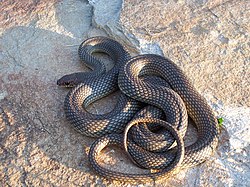| Image | Scientific name | Common name | Distribution |
|---|
| Dolichophis andreanus
(F. Werner, 1917) | Andreas's racer | Iran |
 | Dolichophis caspius
(Gmelin, 1789) | Caspian whipsnake | Albania, Bulgaria, Croatia, Greece, southern Hungary, Kazakhstan, Moldova, Montenegro, North Macedonia, Romania, southern Russia, Serbia, Turkey, southern Ukraine |
 | Dolichophis jugularis
(Linnaeus, 1758) | black whipsnake, large whip snake | Cyprus, Greece, Iran, Iraq, Israel, Jordan, Kuwait, Lebanon, Malta, Syria, Turkey |
 | Dolichophis schmidti
(Nikolsky, 1909) | red-bellied racer, Schmidt's whip snake | Caucasus and Middle East, from Dagestan to Turkmenistan and south into Syria, Jordan, and northern Iran |
|



